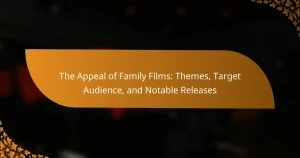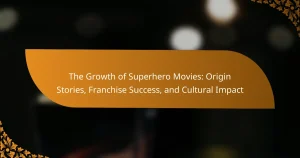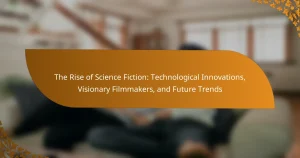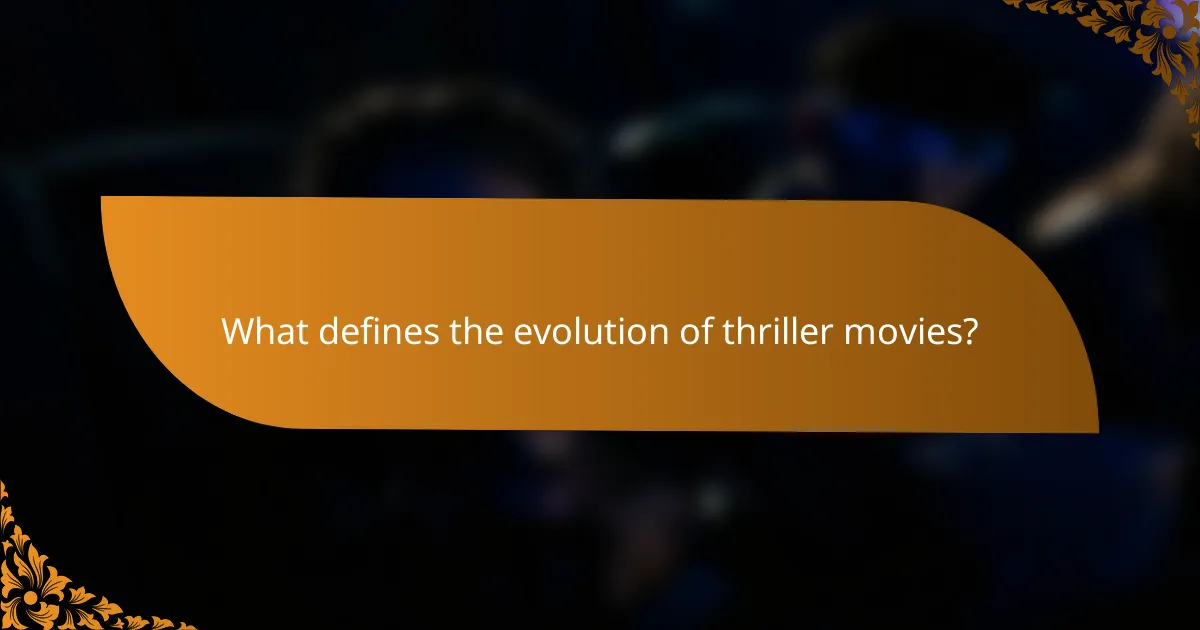
What defines the evolution of thriller movies?
The evolution of thriller movies is defined by changing narrative techniques, themes, and audience expectations. Initially, thrillers focused on suspenseful storytelling and simple plots. Over time, they incorporated complex character development and psychological tension. Iconic directors like Alfred Hitchcock introduced innovative techniques that heightened suspense. The rise of technology also influenced visual storytelling, enhancing cinematic experiences. Plot twists became a hallmark, keeping audiences engaged and surprised. Additionally, societal changes shaped the themes explored in thrillers, reflecting contemporary fears and anxieties. This evolution demonstrates the genre’s adaptability and enduring appeal.
How have plot twists shaped the thriller genre?
Plot twists have fundamentally transformed the thriller genre by enhancing suspense and engagement. These unexpected turns keep audiences on the edge of their seats. They challenge viewers’ assumptions and provoke deeper emotional responses. Iconic films like “Psycho” and “The Sixth Sense” exemplify how plot twists can redefine narratives. Such twists often lead to critical acclaim and box office success. They create memorable moments that become part of popular culture. The use of plot twists has become a hallmark of the genre, setting it apart from others. Overall, plot twists have solidified the thriller genre’s reputation for unpredictability and excitement.
What are some of the most iconic plot twists in thriller films?
Some of the most iconic plot twists in thriller films include “The Sixth Sense,” where Dr. Malcolm Crowe realizes he is dead. “Fight Club” features a twist revealing that Tyler Durden is an alter ego of the narrator. In “The Usual Suspects,” Keyser Söze’s true identity is unveiled at the end. “Se7en” concludes with a shocking revelation about the final victim. “Gone Girl” includes a twist where Amy Dunne manipulates public perception to frame her husband. These twists are pivotal in enhancing suspense and engaging audiences. Each twist has left a lasting impact on the genre, sparking discussions and analyses.
How do plot twists contribute to audience engagement?
Plot twists significantly enhance audience engagement by creating surprise and emotional investment. They challenge viewers’ expectations and provoke curiosity. This element keeps the audience guessing and encourages active participation in the narrative. Research indicates that unexpected plot developments can increase viewer retention and satisfaction. For instance, a study by the University of Southern California found that audiences are more likely to discuss films with surprising endings. This discussion often leads to deeper connections with the material. Thus, plot twists serve as a powerful tool in maintaining viewer interest and fostering a memorable experience.
What role does psychological tension play in thrillers?
Psychological tension is vital in thrillers as it enhances suspense and engagement. This tension keeps audiences on edge, creating an emotional connection to the characters. It often manifests through uncertainty, fear, and anticipation. Filmmakers utilize techniques like music, pacing, and plot twists to amplify this tension. Studies show that heightened psychological tension can lead to increased viewer satisfaction. For instance, Alfred Hitchcock’s films exemplify this by masterfully building suspense through character dilemmas. The successful use of psychological tension can elevate a thriller from ordinary to iconic.
How is psychological tension developed in storytelling?
Psychological tension in storytelling is developed through conflict, character development, and pacing. Conflict creates a struggle that engages the audience’s emotions. Characters with depth and relatable motivations enhance the viewer’s investment. Pacing controls the flow of the narrative, building suspense over time. Techniques like foreshadowing and cliffhangers amplify this tension. For example, Alfred Hitchcock often utilized suspenseful scenarios to keep audiences on edge. His films, such as “Psycho,” exemplify these techniques effectively. The combination of these elements creates a compelling experience that captivates viewers.
What techniques do filmmakers use to create suspense?
Filmmakers use several techniques to create suspense. One common technique is pacing, which involves controlling the speed of the narrative to build tension. Quick cuts and rapid scene changes can heighten anxiety. Another technique is the use of music and sound effects. A suspenseful score can evoke fear and anticipation.
Filmmakers also employ cliffhangers, leaving viewers uncertain about character outcomes. Visual framing, such as close-ups, can intensify emotional reactions. Lighting plays a crucial role; shadows and dim lighting can create an ominous atmosphere.
Additionally, filmmakers often use misdirection to lead the audience to false conclusions. This technique keeps viewers guessing and engaged. These methods have been employed in numerous successful films, demonstrating their effectiveness in creating suspense.
Who are the iconic directors that have influenced thriller movies?
Alfred Hitchcock is a legendary director who significantly influenced thriller movies. He is known as the “Master of Suspense.” Hitchcock’s films often feature psychological tension and unexpected plot twists. His works like “Psycho” and “Rear Window” set new standards for the genre. Martin Scorsese is another iconic director in the thriller realm. His film “Cape Fear” showcases intense psychological elements. David Fincher also made a mark with films like “Se7en” and “Fight Club.” These directors have shaped the evolution of thriller cinema through their unique storytelling techniques.
What unique styles do these directors bring to the genre?
Iconic directors in the thriller genre bring distinct styles that shape their storytelling. Alfred Hitchcock is known for his mastery of suspense and psychological tension. His use of innovative camera angles and editing techniques heightens viewer anxiety. David Fincher employs a dark, meticulous aesthetic, often exploring themes of obsession and moral ambiguity. His films feature intricate plots with unexpected twists. Quentin Tarantino blends thriller elements with nonlinear storytelling and sharp dialogue. His unique approach creates tension through character development and unexpected violence. Christopher Nolan often incorporates complex narratives and mind-bending twists. His films challenge viewers’ perceptions of reality and time. Each director’s style contributes uniquely to the evolution of thriller movies, enhancing their psychological depth and engagement.
How have their contributions shaped modern thrillers?
Their contributions have significantly influenced modern thrillers by introducing innovative narrative techniques. Iconic directors like Alfred Hitchcock pioneered the use of suspense and psychological tension. Hitchcock’s films often featured unexpected plot twists that kept audiences engaged. His approach to storytelling emphasized character psychology, creating deeper emotional connections. Additionally, the use of unreliable narrators became a hallmark of modern thrillers. This technique challenges viewers’ perceptions and enhances intrigue. Furthermore, directors like David Fincher have built upon Hitchcock’s legacy, incorporating dark themes and complex characters. These elements have become staples in contemporary thriller cinema, shaping audience expectations and genre standards.
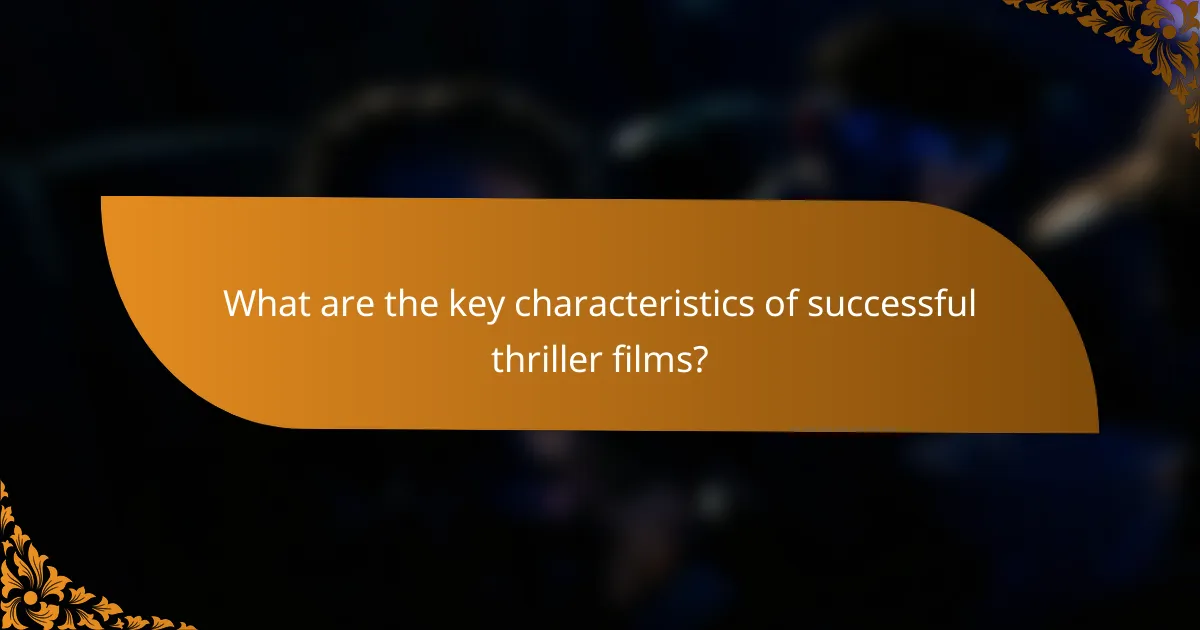
What are the key characteristics of successful thriller films?
Successful thriller films typically feature suspense, tension, and unexpected plot twists. These elements keep audiences engaged and on the edge of their seats. Strong character development is also crucial. Viewers need to connect with the protagonists and antagonists. A well-crafted narrative structure enhances the overall experience. Incorporating psychological elements can deepen the emotional impact. Effective pacing maintains interest and builds anticipation. Cinematic techniques, such as lighting and sound, heighten the atmosphere of suspense. Historical data shows that films like “Psycho” and “Seven” exemplify these characteristics, achieving critical acclaim and box office success.
How do themes and motifs enhance the thriller experience?
Themes and motifs enhance the thriller experience by creating depth and emotional resonance. They establish a framework that guides the narrative and engages the audience. Common themes include fear, betrayal, and survival, which evoke strong emotional responses. Motifs, such as recurring images or symbols, reinforce these themes and create a sense of cohesion. For instance, the motif of darkness often symbolizes danger or the unknown, heightening suspense. Research shows that well-developed themes can lead to increased viewer investment in characters and plot. This investment amplifies tension and anticipation, essential elements in thrillers. Consequently, themes and motifs are crucial for crafting compelling and memorable thriller narratives.
What common themes are explored in thriller movies?
Common themes explored in thriller movies include suspense, fear, and moral ambiguity. These themes create tension and engage viewers emotionally. Psychological manipulation often plays a significant role in the narrative. Many thrillers explore the darker aspects of human nature. Additionally, betrayal and deception are frequently central to the plot. The pursuit of justice versus revenge is another recurring theme. Many thrillers also feature unexpected plot twists that keep audiences guessing. Overall, these themes contribute to the genre’s ability to captivate and intrigue viewers.
How do these themes resonate with audiences?
Thriller movie themes resonate with audiences by engaging their emotions and intellect. These films often incorporate unexpected plot twists that challenge viewers’ perceptions. Psychological tension creates an immersive experience, making audiences feel suspense and anticipation. Iconic directors effectively utilize these elements to craft memorable narratives. Research shows that viewers are drawn to the thrill of uncertainty and surprise. A study by the University of Southern California found that suspenseful storytelling enhances viewer engagement. This engagement is evidenced by increased heart rates and emotional responses during intense scenes. Thus, the combination of plot twists and psychological tension captivates audiences and keeps them invested in the story.
What impact do cinematography and sound design have on thrillers?
Cinematography and sound design significantly enhance the emotional impact of thrillers. Effective cinematography creates visual tension through lighting, camera angles, and composition. For instance, low-angle shots can instill a sense of fear or power. Meanwhile, high-contrast lighting can evoke suspense and uncertainty.
Sound design complements cinematography by manipulating audio elements to heighten anxiety. The use of silence can create a sense of dread, while sudden loud noises can provoke shock. Research shows that sound effects and music cue emotional responses, intensifying the viewer’s experience.
Together, these elements establish an immersive atmosphere. This synergy between visuals and sound engages the audience, making them feel the characters’ fear and tension. Thrillers like “Psycho” and “Se7en” exemplify how cinematography and sound design work in harmony to create unforgettable suspense.
How do visual elements influence the mood of a thriller?
Visual elements significantly influence the mood of a thriller. Lighting creates tension by using shadows and contrast. Dark lighting can evoke fear, while bright light may suggest safety. Color palettes also play a crucial role. For instance, red can symbolize danger or violence. Camera angles contribute to the emotional impact. Low angles can make characters appear threatening, while high angles can portray vulnerability. Composition guides viewer focus, enhancing suspense. Close-ups can heighten emotional intensity, drawing the audience into the character’s experience. These techniques are employed deliberately to create a gripping atmosphere, as seen in films like “Se7en” and “Psycho.”
What role does sound play in building tension?
Sound plays a critical role in building tension in thriller movies. It enhances the emotional experience of the audience. The use of dissonant chords creates a sense of unease. Sudden loud noises can provoke shock and surprise. Subtle background scores increase anticipation and suspense. Silence can also heighten tension by creating an atmosphere of uncertainty. Research shows that sound design influences viewer perception and emotional response. For example, a study by the University of Southern California found that sound significantly affects the intensity of fear experienced by viewers. This demonstrates sound’s essential function in amplifying tension in cinematic storytelling.
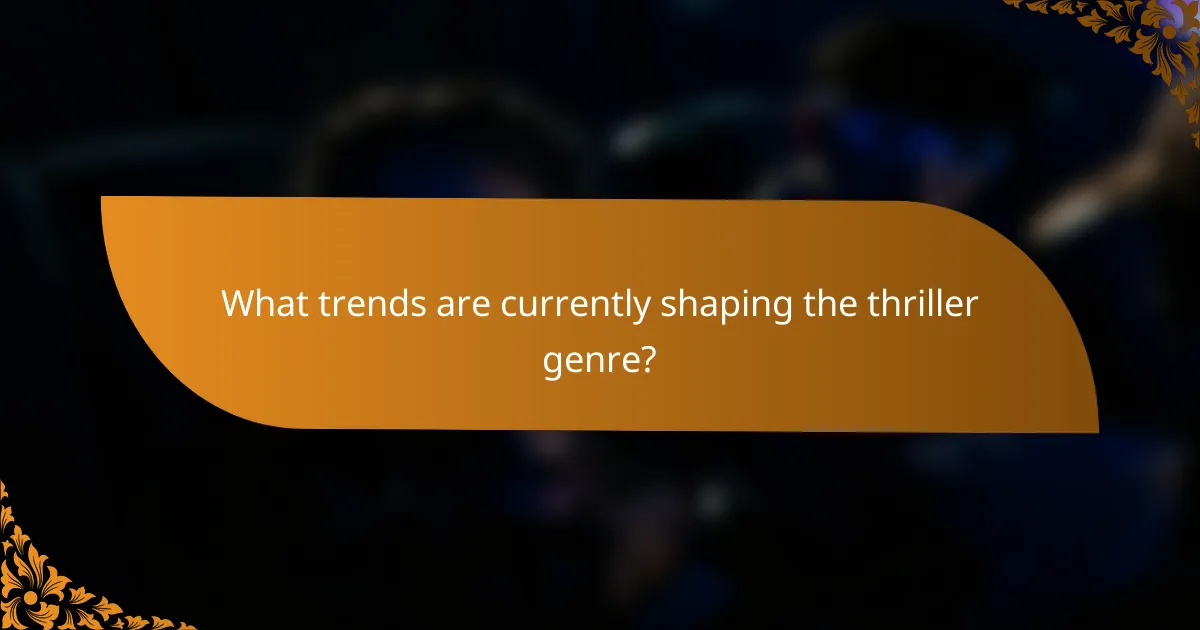
What trends are currently shaping the thriller genre?
Current trends shaping the thriller genre include psychological depth, diverse storytelling, and technology integration. Psychological thrillers are gaining popularity. They focus on character motivations and emotional tension. This trend is evident in films like “Gone Girl” and “Parasite.” Diverse narratives are also emerging. They incorporate various cultural perspectives and experiences. This shift broadens audience appeal and engagement. Technology plays a significant role in modern thrillers. Films often explore themes of surveillance and digital manipulation. Examples include “Searching” and “Unfriended.” These trends reflect a dynamic evolution in the genre. They respond to audience expectations and societal changes.
How has technology influenced modern thriller filmmaking?
Technology has significantly influenced modern thriller filmmaking by enhancing visual storytelling and audience engagement. Advanced special effects allow filmmakers to create more immersive and realistic scenarios. High-definition cameras improve image quality, capturing intricate details that heighten tension. Digital editing software enables seamless transitions and innovative narrative techniques. Streaming platforms have expanded distribution, making thrillers accessible to wider audiences. Additionally, data analytics help producers understand viewer preferences and tailor content accordingly. These technological advancements have transformed how thrillers are conceptualized, produced, and consumed.
What are some examples of innovative techniques in recent thrillers?
Recent thrillers have employed innovative techniques such as non-linear storytelling and unreliable narrators. Non-linear storytelling disrupts chronological order, creating suspense through fragmented narratives. Films like “Memento” and “Tenet” exemplify this technique effectively. Unreliable narrators challenge viewers’ perceptions, as seen in “Gone Girl” and “Fight Club.” These narratives keep audiences guessing about the truth. Additionally, blending genres, such as horror and thriller, has emerged in films like “Get Out.” This fusion enhances psychological tension and captivates viewers. Finally, immersive technologies like virtual reality are being explored. These innovations push the boundaries of traditional storytelling in thrillers.
How do streaming platforms affect the distribution of thriller films?
Streaming platforms significantly enhance the distribution of thriller films. They provide broader access to diverse audiences. Traditional distribution methods often limit reach to specific regions. Streaming services can release films globally simultaneously. This approach increases viewership and engagement. According to a 2021 report by Statista, streaming accounted for over 80% of video-on-demand revenue. Platforms also invest in original thriller content, attracting more subscribers. This trend reshapes audience expectations for thriller storytelling and production quality.
What can audiences expect from the future of thriller movies?
Audiences can expect increased incorporation of technology in thriller movies. Innovations like artificial intelligence and virtual reality will enhance viewer engagement. Filmmakers are likely to explore complex narratives that challenge traditional storytelling. Psychological tension will remain a focal point, pushing boundaries of character development. Diverse perspectives and global narratives will enrich the genre. Data from the Motion Picture Association indicates a rise in international co-productions in thrillers. This evolution aims to captivate audiences with fresh, unpredictable experiences.
What emerging themes are likely to dominate upcoming thrillers?
Emerging themes likely to dominate upcoming thrillers include technology-driven narratives, psychological manipulation, and social commentary. Technology-driven narratives explore the impact of artificial intelligence and surveillance on personal privacy. Psychological manipulation delves into the mind’s complexities, showcasing unreliable narrators and twisted perceptions. Social commentary addresses contemporary issues such as systemic injustice and societal fears. These themes resonate with current global concerns and reflect audience anxieties. Recent films have successfully integrated these elements, indicating a trend toward deeper, more thought-provoking storytelling in the thriller genre.
How can viewers identify potential thriller hits before they release?
Viewers can identify potential thriller hits before they release by analyzing marketing trends, cast and crew, and early reviews. Tracking social media buzz can reveal audience anticipation. Notable directors and writers often indicate quality; for example, films by Alfred Hitchcock or David Fincher typically garner attention. Film festivals frequently showcase upcoming thrillers, providing early insights. Additionally, platforms like IMDb and Rotten Tomatoes offer pre-release ratings and trailers that help gauge interest. Historical data shows that films with strong pre-release marketing often perform well at the box office.
The main entity of the article is the evolution of thriller movies, highlighting critical elements such as plot twists, psychological tension, and the influence of iconic directors. The article explores how narrative techniques and audience expectations have changed over time, emphasizing the role of plot twists in enhancing engagement and suspense. It also examines the contributions of renowned directors like Alfred Hitchcock and David Fincher, who have shaped modern thrillers through innovative storytelling and psychological depth. Additionally, the article discusses current trends and emerging themes, including technology-driven narratives and social commentary, that continue to redefine the genre.
